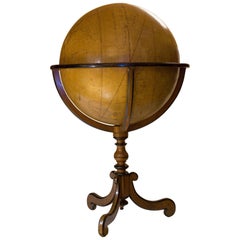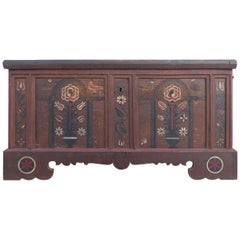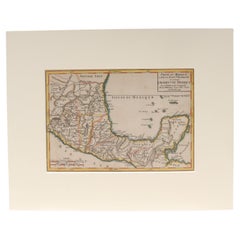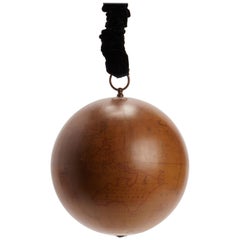Mid-18th Century Globes
5
to
5
5
5
5
1
1
16
79
175
25
30
97
24
7
4
10
11
31
16
6
4
4
2
2
2
1
4
2
1
1
1
Period: Mid-18th Century
A truly delightful miniature terrestrial pocket globe
Located in ZWIJNDRECHT, NL
A truly delightful miniature terrestrial pocket globe in a celestial case, 3 inches / 6.8 cm. The globe consists of 12 wonderful varnished, engraved hand-coloured gores that stretch from pole to pole. In the original case of black fish-skin with a brass hinge and two brass hook-and-eyelet closures, case with a unique silver plaque which reads:
"B. Bellchamber S. King - Gul's Fox Summum Geographicum Praemium Pares Meruere". *
[This very roughly translates to:]
"B. Bellchamber S. King - Gul's Fox Earns Top Geographical Peers Award".
*Is it too much to suppose and speculate that this wonderful silver plaque attached to the outer case is in recognition of a [geographic?] scholastic achievement? The prize awarded to the lucky recipients (B. Bellchamber & S. King?) is this globe?
This terrestrial globe has two repairs; to the area concerning the British Isles, and also to parts of Europe and Scandinavia (with some loss). There is some slight loss to a portion of North America, and there is a crack to the northern portion of South America. It is partly worn in other places and has some slight spotting. It is lacking the axis metal pin, and the two holes that normally allow for this pin have been closed. The case is split and segmented, partly rubbed and worn with cracks, (as is usual.) The case will close. There is some minor chipping and cracking to the outer rim of the inside of the case.
About Pocket Globes.
It is generally thought that Joseph Moxon brought pocket globes to England in the late seventeenth century. These globes usually consist of a terrestrial sphere of about 7.5 cm in diameter that fits into an outer case (usually made of fish-skin). The interior of this case often bears bright, colourful celestial cartography, so you effectively have the celestial heavens surrounding the terrestrial earth.
Pocket globes, although highly desirable, are for all intents and purposes somewhat impractical, as their size makes accurate calculations impossible. Few, if any, pocket globes came with accompanying booklets, so it is hard for anyone to know who used them and for what purposes.
Pocket globes could simply have served purely as status symbols for wealthy gentlemen, who had an interest in geography or astronomy. The fields of geography and the sciences were quickly advancing during this period. Alternatively, pocket globes could be seen as a tool used in children’s education, especially when you think that they are construction from cheap materials such as papier-mâché.
Points of Interest.
This particular globe shows California as a peninsula, whereas previously it had been depicted as an island – a misconception dating back to the sixteenth century; it has the northwest coast of America simply as "unknown parts."; - due to a profound lack of knowledge of the region; the track of Admiral George Anson’s circumnavigation of the world (1740-44) is drawn – Anson led a squadron of eight ships on a mission to disrupt or capture the Pacific Ocean possessions of the Spanish Empire, for emphases, the trade winds are indicated by red arrows. There are three large lakes engraved in Africa that may longer exist.
The Celestial Gores.
The celestial gores, housed within the case, are fun and eye-catching both in their display and in their content. Constellations and both hemispheres and are represented.
Gemini, Cancer, Virgo, Orion, Andromeda, Taurus, Leo, Ursa Major etc in the north, and Scorpio, Libra, Canis Major etc in the south.
A celestial globe is a mapping of the stars, and has been used since classical times. Celestial globes were first used by Greek astronomers, and later by the Islamic world, where the earliest known globes date from the eleventh century. The stars were thought to sit on the surface of a giant sphere around the earth, and the constant movement of the stars each night and throughout the year appeared to be caused by this giant sphere slowly turning overhead. In line with its counterpart, the terrestrial globe, celestial globes are mapped by a north and a south pole, an equator, and lines of latitude and longitude.
The Terrestrial Globe.
The North Pole encompasses the Arctic Circle, Baffin Bay (Canada), Iceland, Greenland, northern Siberia and Nuova Zembla.
Europe shows the Dominion of Muscovy (a principality of the late Middle Ages centered on Moscow), Turkey, the British Isles, Italy etc.
Africa highlights the Barbary coast, Biledulgerid (a former country in North Africa), the Zaara Desart (Sahara Desert), Negroland (an archaic term in European mapping referring to large portions of West Africa), Guinea, Ethiopia, Congo, the islands of the Azores and the Canaries.
Australia (New Holland) shows the outdated cartography of an incomplete coastline; The West Australian and Northern Territory coastlines are in full, however, there is no connected mainland coastline from South Australia up to Northern Queensland. Papua New Guinea is still thought to be a part of the Australian mainland. A portion of Tasmania’s coastline is engraved. The only places/regions mentioned are: Dimens Land and Carpentaria in the north; Lewins, St. Francis, Mary’s Island, South Cape, and Dimens Land in the south.
Interestingly, a place named Hartog’s Island is mentioned off the West Australian coast. This island has a unique place within Australia’s history as it is the first recorded European landing on Australian soil in 1616 by the island’s namesake, Dutch captain Dirk Hartog...
Category
British Dutch Colonial Antique Mid-18th Century Globes
Materials
Other
18th Century Celestial Globe
Located in Mjöhult, SE
Rare 18th century celestial globe (Globus Coelestis) on a stand in mahogany and blackened wood by Anders Akerman, 1759.
In 1758, the "Cosmographic Society" was formed in Uppsala, ...
Category
Swedish Rococo Antique Mid-18th Century Globes
Materials
Brass
Pair of Table Globes by Josiah Loring, Dated 1844 and 1841
Located in Lymington, Hampshire
A pair of 12 inch table globes by Josiah Loring, dated 1844 and 1841. Each globe is set into a fruitwood stand with four baluster turned legs and stretchers, the terrestrial globe wi...
Category
American Antique Mid-18th Century Globes
Materials
Fruitwood
Colossal Terrestrian Globe Hand Painted, French, First Half of the 18th Century
Located in Saint-Ouen, FR
Colossal Terrestrian globe hand painted, French, first half of the 18th century.
Mounted in a 19th century pedestal wood.
Category
French Antique Mid-18th Century Globes
Materials
Beech
Pocket Globe by Nathaniel Hill, London 1754
Located in Milano, IT
Nathaniel Hill
Pocket globe
London, 1754
The globe is contained in its original case, which itself is covered in shark skin.
There are slight gaps in the original paint on the sphere. The case no longer closes.
The sphere measures 2.6 in (6.8 cm) in diameter whereas the case measures 2.9 in (7.4 cm) in diameter.
lb 0.24 (kg 0.11)
The globe is made up of twelve printed paper gores aligned and glued to the sphere.
In the North Pacific Ocean there is a scroll with the inscription:
A
New
terrestrial
Globe
by
Nath. Hill,
1754.
The celestial globe is depicted on the inside of the box.
On the terrestrial globe much of central and southern Africa is empty. North America bears only the name of some British colonies. It shows California as a peninsula and the northwest coast of America as "unknown parts" (Alaska is not described and is only partially delineated; it would become part of the United States in 1867). The route of Admiral Anson is traced (1740) and the trade winds are indicated by arrows. Australia, still named New Holland (the new name would be introduced in 1829), is part of the west coast. (See Van der Krogt, P., Old Globes in the Netherlands, Utrecht 1984, p. 146 and Van der Krogt, P. - Dekker, E., Globes from the Western World, London 1993, p. 115.)
Nathaniel Hill (London, news from 1746 to 1768) had impeccable professional credentials: he had done his apprenticeship with Richard Cushee, who at the time was carrying out surveying work for John Senex's Surrey map...
Category
English George II Antique Mid-18th Century Globes
Materials
Shagreen, Paper
Related Items
Late 18th Century Hand Painted Bavarian Dowry Chest Dated 1767
Located in Miami, FL
Late 18th century hand painted Bavarian dowry chest dated 1767
Offered for sale is a Bavarian hand painted dowry chest with cast iron handles, e...
Category
German Primitive Antique Mid-18th Century Globes
Materials
Wood
Replogle Terrestrial Floor Globe
Located in Asbury Park, NJ
This floor globe by Replogle floats within a ring of walnut, supported by four 'turned' chrome stiles, which connect to a base of walnut. The ...
Category
American Mid-Century Modern Vintage Mid-18th Century Globes
Large and Extremely Rare Terrestrial Globe by Newton
By Newton Globes - Planer & Newton
Located in Lymington, Hampshire
A large and extremely rare 24-inch terrestrial globe by Newton
Our most magnificent and rare globes were a pair of 24-inch Newton globes.
These too were updated in 1852 (terre...
Category
English Antique Mid-18th Century Globes
Materials
Mahogany
Pair Italian World Globe Bookends
Located in Douglas Manor, NY
3-455, pair Italian revolving globe bookends.
Category
Vintage Mid-18th Century Globes
Materials
Fruitwood
An exceptional pair of BLAEU table globes
By Willem Blaeu
Located in ZWIJNDRECHT, NL
A very rare set of globes, 9 inch / 23cm, with an overall height of 38 cm, Amsterdam, dated 1602, but published after 1621. In their original stands with circular wooden horizon rings, covered with printed paper, supported by four legs and brass meridian rings supported by a single column.
The terrestrial and celestial globe are made up of a set of 12 engraved gores, heightened in gold and Arctic ice caps, printed on paper and mounted on a plaster sphere of papier maché. Each sphere is mounted in a graduated brass meridian ring with the production number stamped at the back of the ring. Both globes are mounted on four-legged ebonized oak Dutch stands, which support the horizon ring. The legs are connected by two crossbeams which support a circular base plate with central support for the meridian ring. The horizon rings are covered with printed paper. With usual defects: paper equinoctial tables present gaps that are filled and restored; small splits along gores; several partially deleted entries; on the globe, the date 1602 and the text of the cartouche in America, are illegible ; small scattered spots but in general in good condition for such an early globe pair of which presently only 19 pair are recorded.
These 9-inch globes are among the rarest since very few copies of them are known to exist, in comparison with the smaller or larger globes of Blaeu (4, 6, 13.5, and 26 inches). Blaeu's terrestrial globes were highly valued and were much in demand, because of the care with which they had been prepared, because of the efforts to give the latest information on discoveries, and because of the loxodromic lines that made them of special value to navigators.
His celestial globes were appreciated for the fact that he had been the pupil of Tycho Brahe, who was himself known to be the greatest astronomer of his time.
Willem Janszoon Blaeu (1571–1638), originally trained in astronomy, he quickly became a leading maker of maps, atlases and instruments. Blaeu’s globes were luxury items for wealthy and intellectual merchants and nobility who benefited from Blaeu’s access through the Dutch East India Company to the latest navigational discoveries and geographical information.
Willem Jansz Blaeu collected information that Dutch mariners gathered from around world and brought back to Amsterdam. Crews were instructed to record information about the lands they visited and the skies they saw. Blaeu incorporated these observations in maps and globes. Through his web of contacts and thanks to assiduous research, he was also able to obtain the most recent information about the latest discoveries in the western hemisphere and the South Pacific, where Dutch explorers were particularly active at the time.
Since the globe was published after 1618, Blaeu was able to include the discoveries made by Henry Hudson in his attempt to find a passage to the East Indies. He also included recent Pacific discoveries of the celebrated voyages of Willem Cornelis Schouten and Jacob Le Maire, who both traversed the South Pacific and the Atlantic. The findings of Schouten and Le Maire in the Tierra del Fuego region are also incorporated.
The Strait of Le Maire is drawn and the hypothetical southern continent is labelled “Terra Australis Incognita Magalanica”. Olivier van Noort’s track is drawn and labelled. His route is indicated with a broken line and the words: “Navigationis Olivierij ductus” (several times). There are various decorative features, such as animals on the different continents, many ships on the high seas and allegorical and mythical figures around the cartouches.
The nine-inch globe is not just a smaller version of the one published in 1599. Drawings of animals and people do often correspond to those on the earlier globe, but Blaeu made several significant changes.
- The west coast of North America is drawn differently and the river system of Brazil is altered.
- The hypothetical southern continent is labelled: Terra Australis Incognita Magallanica.
- There are nine ocean names in handsome curling letters: Mare Congelatum, Mare Atlanticum, Oceanus Aethiopicus, Mare Arabicum et Indicum, Mare di India, Oceanus Chinensis, Mar del Zur, Mare Pacificum, Mar del Nort.
- Willem Blaeu...
Category
European Dutch Colonial Antique Mid-18th Century Globes
Materials
Other
Celestial Table Globe by Harris and Son
Located in Lymington, Hampshire
A 12 inch celestial table globe by Harris and Son, the horizon ring, with the original papers, set on four turned mahogany legs, the label statin...
Category
English Antique Mid-18th Century Globes
Materials
Mahogany
German Rococo Four Panel Painted Screen, Mid-18th Century
Located in Spencertown, NY
The 4 panels depicting fete galante scenes within cartouches. old cracquelure to paint, loss of paint to corners.
Category
German Rococo Antique Mid-18th Century Globes
Materials
Canvas
18-inch Globe, Cary's, London, 1840
By Cary’s
Located in Milano, IT
John and William Cary
Updated by George and John Cary
Terrestrial Globe
London, 1840
lb 22 (kg 10)
Slight surface abrasions due to use. A small crack on the horizon circle.
The globe rests in its original Dutch style stand with four supporting turned wood columns.
It measures 26 in in height x 23.6 in in diameter with the diameter of the sphere measuring 18 in; 66 cm in height x 60 cm in diameter with the diameter of the sphere measuring 45.72 cm.
The 18 inch...
Category
English Early Victorian Antique Mid-18th Century Globes
Materials
Wood, Paper
Antique World Globe From Fleet Street London 1923 on Wooden Stand
Located in High Wycombe, GB
Antique Terrestrial Geographia of Fleet Street London 12"inch World Globe on handcrafted Wooden Three Legged Base 1923
Made 55 Fleet Street, London
Beautiful desktop globe, sho...
Category
British Art Deco Vintage Mid-18th Century Globes
Materials
Wood, Paper
18th Century Spanish Trunk, Coffre
Located in Atlanta, GA
A very charming 18th Century Coffre - Trunk from the Catalan region of Spain. Soundly constructed from naturally washed pine with dovetail construction and iron strapping. Wonderful patina. Perfect at the foot of a bed or under a picture window.
Category
Spanish Antique Mid-18th Century Globes
Materials
Pine
19th Century German Miniature Pocket Terrestrial Globe
Located in Essex, MA
A miniature 19th century 3.5 inch diameter pocket terrestrial globe by C. Abel-Klinger, Nuremberg, Germany, in English for the English speaking markets. Signed with cartouche reading...
Category
German Antique Mid-18th Century Globes
Materials
Brass
World Globe With Wooden Foot, and Brass 20th Century
Located in Mombuey, Zamora
Beautiful and elegant ball of the world to decorate any studio, living room or bedroom, it is small, with the base about 26 cm high and 10 wide.
Category
Italian Other Mid-18th Century Globes
Materials
Brass
Previously Available Items
Antique 18th Century Map of Mexico and Central America by Robert DeVaugody
Located in Philadelphia, PA
A fine antique printed & hand colored map.
By Robert DeVaugody,
Published in the Atlas Portrait Universel, Paris, 1749
Matted and ready for framing.
Simply a wonderful 18th Century Mexican map...
Category
French Baroque Antique Mid-18th Century Globes
Materials
Paper
H 11.5 in W 14.5 in D 0.13 in
Terrestrial Globe French 18th Century, Swinging Structure
Located in Milan, IT
Designed, created, and built to be hanged to the ceiling in order to spin and play with it. Rare are the cases of pre-revolutionary French globes, and most of all the swinging ones. ...
Category
French Antique Mid-18th Century Globes
Materials
Wood, Paper
Fine 18th Century English Terrestrial Pocket Globe by Cary, London, 1791
By Cary’s
Located in Oxfordshire, United Kingdom
Cary’s Pocket globe, agreeable to the latest discoveries, London: J&W Cary, Strand, April 1791
A rare 3 inch diameter example of Cary’s pocket globe in a superb green shagreen-cover...
Category
British George III Antique Mid-18th Century Globes
Materials
Paper, Shagreen
Fine 18th Century English Celestial Pocket Globe by Nathaniel Hill, London, 1754
Located in Oxfordshire, United Kingdom
A fine and rare 18th century English terrestrial and celestial pocket globe by Nathaniel Hill in its original black pebbled fish skin case dated 1754 titled "A new Terrestrial GLOBE ...
Category
British George II Antique Mid-18th Century Globes
Materials
Shagreen, Paper
H 3 in Dm 3 in L 3 in
1754 Nathaniel Hill Pocket Globe
Located in Lincolnshire, GB
A 1754 edition of a Nathaniel Hill pocket globe in the original fish skin case, retaining good color to the gores. A fantastic piece.
Category
English Antique Mid-18th Century Globes
Materials
Paper
Rare 18th Century German Baroque Terrestrial Table Globe by Doppelmayr
By Johann Gabriel Doppelmayr 1
Located in Worpswede / Bremen, DE
The globe made up of twelve hand colored engraved gores with cartouche inscribed: “Globus Terrestris Novus operâ IOH. GAB. Doppelmairi M.P.P. exhibitus â Ioh. Georg Puschnero Chalcog...
Category
German Baroque Antique Mid-18th Century Globes
Materials
Brass
Nathaniel Hill Pocket Globe, 1754
Located in Lincolnshire, GB
A fine 18th century pocket globe by Nathaniel Hill in the original shagreen case.
This is a superb example of a dated pocket globe retaining all the orig...
Category
Antique Mid-18th Century Globes
Materials
Shagreen
18th Century French Planetarium and Armillary Sphere by L.-C. Desnos, 1754
By Louis Charles Desnos
Located in Milano, IT
Copernican Planetarium and Ptolemaic Armillary sphere
Louis-Charles Desnos (Beauvais, 1725 – Paris, 1791)
Paris, the Planetarium 1754; the Armillary Sphere ante 1757
Copernican ...
Category
French Louis XV Antique Mid-18th Century Globes
Materials
Paper, Wood
Ferguson 18th Century Pocket Globe
Located in Lincolnshire, GB
A good example of a James Ferguson 3" pocket globe in original fish skin case.
Category
English Antique Mid-18th Century Globes
Recently Viewed
View AllMore Ways To Browse
French Gray Commode
Midcentury Modern L Desk
Table Chair Set Square
Oyster Cabinet
Pair French Cabinets Small
Marble Top Dresser Drawers
Mid Century Vanity Cabinet
Black American Dining Chairs
English Oak Drop
Antique Brass Hardware Pulls
Kitchen Storage Racks
Kitchen Tables Teak Mid Century
Drawer Stack
Console Pair Neoclassical
Unique Vintage Chest Of Drawers
Back Dining Head Chair
Vintage Dressing Case
Carved Chinese Console Table Carved







